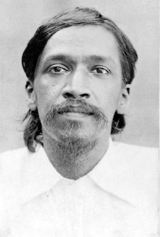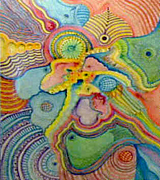Integral Health
The metaphysical basis for Integral Health — the nature of reality
In Chapter V of The Life Divine, Sri Aurobindo introduces a concept which has not only a bearing metaphysical thought but has enormous consequences in the fields of science and health:
“... the Reality is one and not a sum or concourse (1).”
To have a clear idea of the metaphysical basis of this statement, we need to appreciate three terms:
a. Being
b. Non-Being
c. Becoming
Sri Aurobindo has already elaborated in Chapter IV of The Life Divine the nature of the Omnipresent Reality behind all manifested phenomena. That ‘Reality’ has been conceived as Being when invested with positive attributes and termed as Non-Being when conceived to have surpassed all cognitive criteria needed for description.
The nature of this Omnipresent Reality (whether called ‘Being’ or ‘Non-Being’) is that it is the sole or ONE Reality – infinite, eternal, absolute – Ekam Evadvitiyam (Sanskrit for ‘One without a second’) (2). The Omnipresent Reality supports all phenomena that have manifested within the matrix of space and time. If the Omnipresent Reality behind all manifestation is called the Being, all that has manifested within the field of space and time constitutes the Becoming.
How do we come to the conclusion that despite the multiplicity of the Becoming, the Reality (or Brahman) is One? This oneness is not a statistical concept. It is not derived from the summation of all manifested phenomena. Nor is it derived from the gestalt concept that the whole is more than the sum of the parts.
Now, the Reality or Being (or Brahman) is also experienced as a triune of Existence (Sat), Consciousness (Chit) and Bliss (Ānanda) —(Sachidananda). Even here, the One Reality is not a summation of three experiential terms. Instead, each term of this triune represents a particular poise of Reality. “There is effective determination, definition and demarcation, diverse formation in the universe but no essential separation or division. A tree is separate as an object or phenomenon, but it is not a separate existence divided from all around it; there is a one-existence and a one-energy that has taken form of tree, constitutes every atom, molecule, fibre of it, pervades and is its whole structure of being and this existence, this energy not only abides in all of it and flows through all of it but extends everywhere around and is, constitutes, energises all other objects in the cosmos (3).”
“The One is at the same time the All, for it exists in all, all exists by it, it is all (4).”
Oneness and multiplicity
The Omnipresent Reality is not only represented by the Being, but also by the Becoming. The ‘spiritual mindset’ deals with Being in its purity and considers the universe to be an unreal dream. The ‘material mindset’ deals with the multiplicity of the Becoming and considers God and the Beyond as illusory ideas. Both conceptions are partial representations of the essential Truth. The knowledge of Oneness (also called Vidya) is equally important as the knowledge of the relative and multiple (also called Avidya). Without Vidya, the knowledge of the multiplicity is “a night of darkness and a disorder of ignorance” and if multiplicity is dismissed as unreal and non-existence, ‘Vidya’ becomes obscure and imperfect. This is the real meaning of the famous verse in the Isha Upanissad:
“By the Ignorance they cross beyond Death and by the Knowledge enjoy Immortality…(5)”
(‘Ignorance’ is knowledge of multiplicity, of the transient phenomena that constitutes the universe, ‘knowledge’ is realisation of the Oneness, the essence).
The realisation that the unity in existence is due to a oneness in essence that permits the variegated multiplicity gives credence to the study of body and mind as having distinctive characteristics despite having a commonality in consciousness. The Cartesian dualism essentially considers that the mind and body are non-identical. The body which includes the brain is made of extended, divisible substance while the mind is not. Even if they interact, the mind is considered to be independent of the body, including the brain. This postulate admits a paradoxical situation where the mind is independent of the body yet interacts with the body. Does that mean that the body is vulnerable and receptive to non-material forces? Not to be cowed down by the leverage to non-material factors, neurophysiologists argue that the non-material forces originate from matter itself. It as if the nerves and hormones are solely responsible for our creative thoughts, intuitive ideas and creative potentials.
Both the Cartesian dualism and the scientific postulate that consciousness is a by-product of matter are based on partial knowledge. The Upaniṣads are catholic enough to assert that this partial knowledge has temporal relevance. It is through Avidya that the trajectory of progress crosses death. Translated in material terms, this statement is justified by the fact that the pursuit of the variety and variability of the material world has revealed the details of the manifestation extending to the cellular and sub-atomic levels, a revelation that has helped to build the citadel of science, conquered the barriers of space and time and decreased morbidity.
Yet the very fact that the knowledge of the multiplicity is Avidya, the Great Ignorance, brings home the fact that it has its limitations and has to give way to wisdom, the perennial knowledge of the oneness, the Vidya which the Upaniṣads assert to impart the enjoyment of immortality. The realisation that sub-atomic particles like leptons and quarks cannot be subdivided further as they lapse into formlessness points to some underlying unitary substrate, an ethereal matrix or consciousness. It must be a substrate with an essential oneness where the creation gets organised for manifestation. The bottoms-up approach to construct a model of reality can no longer stand ground, for ostensibly, the foundation of all things appear to be in a flux, floating in an ether where no forms but only impressions of movements remain. This is how when scientists could not visualise any further, they ascertained the presence of sub-atomic particles by studying how protons (composed of quarks) got deflected when fired by electrons. Using this model, Nobel Laureates Friedman, Kendall and Taylor revealed a new level of matter by studying angles of scattered particles. The mystics had a more refined perception when they described that the subtle transcripts in consciousness preceded the manifestation of forms.
Sri Aurobindo describes how consciousness is simultaneously pluri-dimensional and integral. Moreover it is also simultaneously transcendental, universal and individual. The Supreme creative consciousness is situated in the Transcendental plane, where creative ‘Real-Ideas’ are programmed. These are supramental archetypal ideas that have in-built energy for execution and are translated as transcripts in the universal consciousness from where they materialise into individual forms. If the Supreme creative consciousness is at one end of the spectrum of consciousness, the material world is at another end of the continuum. In between lies the whole range of consciousness organised as planes, energy-substrates and matrices of ‘Knowledge-Force’(known as Chit-Śakti in the Indian tradition). It is in this gestalt that the human being manifests.
Reality is thus represented by an all-encompassing consciousness where the unitary essence does not belittle the multiplicity. Translated in practical terms in the domain of physical sciences, the exploration of the atomic structure is as necessary as the appreciation of the primal ether in which all sub-atomic particles lapse by becoming formless. In the domain of health, the proliferation of multiple specialist disciplines catering to different organ systems are important but can lose relevance if it is not related to the well-being that arises by being pivoted around what is the immortal essence in us. This is because at the end, Reality is one and not a sum or concourse.
References
1. Sri Aurobindo. Birth Centenary Library, Volume 18. Pondicherry: Sri Aurobindo Ashram Trust; 1970, p.33.
2. Sri Aurobindo. Essays Divine and Human. Pondicherry: Sri Aurobindo Ashram Trust; 1994, p. 196.
3. Ibid., p. 195.
4. Ibid., p. 194.
5. Sri Aurobindo. SABCL, Volume 12. 1971, p.66.
Share with us (Comments, contributions, opinions)
When reproducing this feature, please credit NAMAH, and give the byline. Please send us cuttings.




